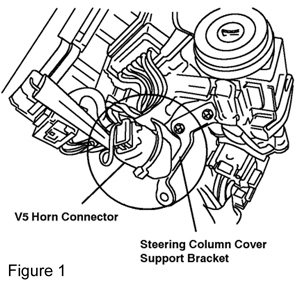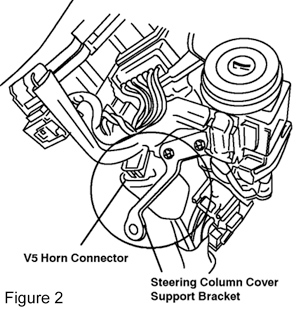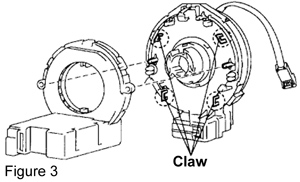Certain 2004 Toyota Scion xB vehicles with the V5 security system may come into the shop with the Vehicle Skid Control (VSC) and Anti-Lock Brake (ABS) lights on and DTC C1231 set. If the vehicle’s security system was not installed correctly, interference could be experienced when the steering column cover is reinstalled or when service work is performed. If DTC C1231 comes on, it will be necessary to replace the steering angle sensor and ensure the V5 horn connector is properly routed during reassembly.
Applicable Vehicles: 2004 Scion xB vehicles equipped with the V5 security system produced before the production change effective VIN: JTLKT334440163535.
Repair Procedure
The VSC steering angle sensor is located below the steering wheel on the steering column.
1. Position the front wheels facing straight ahead.
2. Separate the battery negative terminal.
3. Remove the lower steering column cover.
4. Locate the V5 horn connector mounted under the steering column cover support bracket (see Figure 1). 
Note: The V5 horn connector is wrapped in gray foam padding.
5. Remove the zip tie.
6. Relocate the V5 horn connector above the steering column cover support bracket as shown in the illustration. Ensure that the connector does not contact the steering angle sensor connector when the column cover is reinstalled. The correct mounting location is behind the mounting bracket of the lower steering column cover (see Figure 2). 
7. Re-install zip tie.
8. Replace the steering angle sensor, P/N 89245-52010 (see Figure 3). 
a. Remove the horn button assembly.
b. Remove the steering wheel assembly.
c. Remove the spiral cable sub-assembly.
d. Remove the steering sensor
• Release the four claw fittings and remove the steering sensor from the spiral cable.
e. Install the steering sensor
• Install the steering sensor to the spiral cable. Install the claw securely and do not damage the claw.
f. Adjust the center front wheel.
g. Install the spiral cable sub-assembly.
h. Center the spiral cable.
i. Install the steering wheel assembly.
j. Inspect the steering wheel center point.
k. Install and inspect the horn button assembly.
l. Inspect the SRS warning light.
m. Perform the VSC system calibration.
n. Reset the ABS warning light and VSC warning light.
Courtesy of ALLDATA.
For additional information, visit www.alldata.com.













